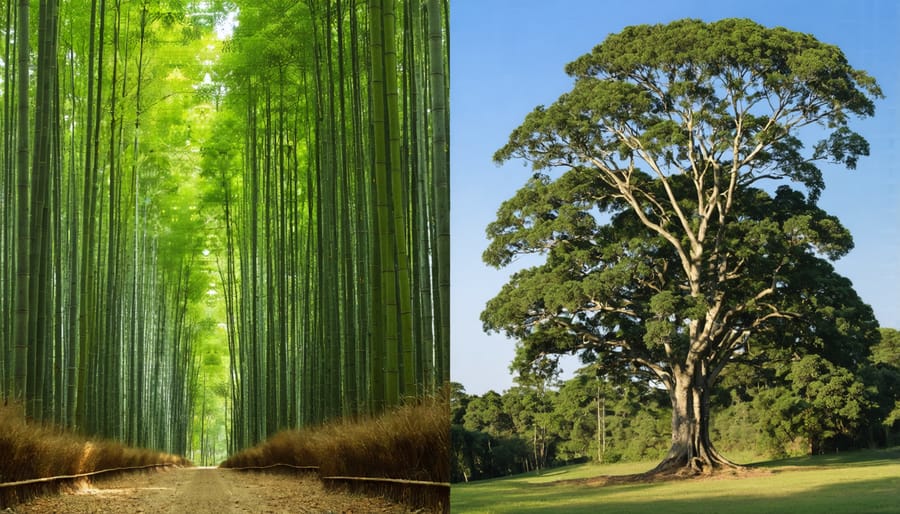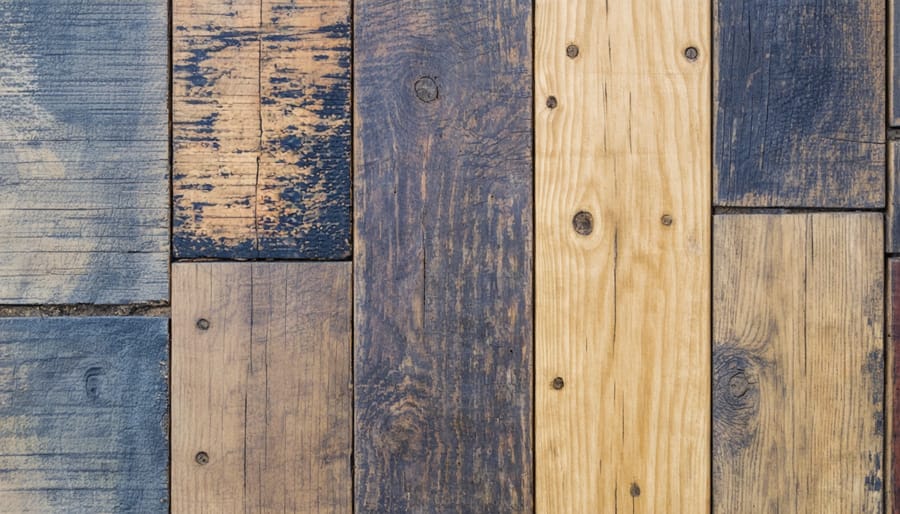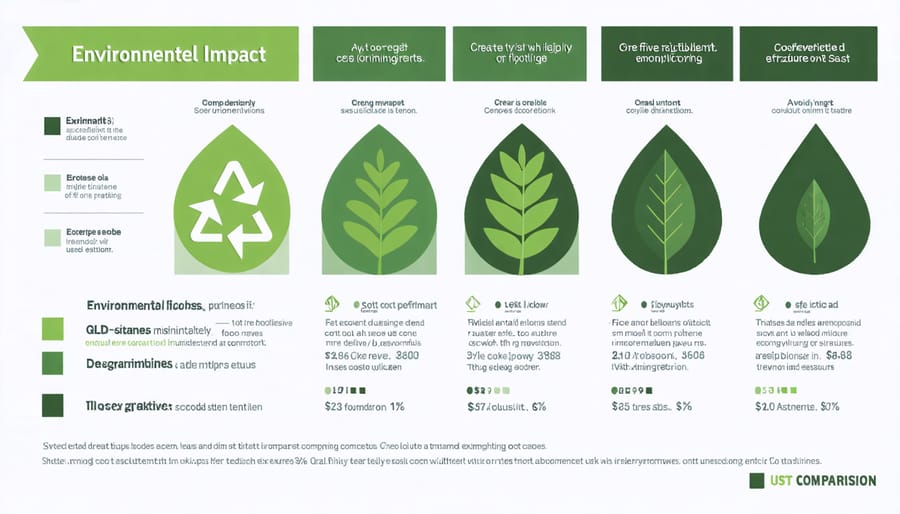Transform your home’s environmental impact by choosing the right sustainable flooring – a decision that goes far beyond aesthetics. Bamboo, cork, and reclaimed wood stand out as nature’s champions in eco-friendly flooring, each offering unique benefits for conscious homeowners. While bamboo regenerates in just 3-5 years and absorbs more carbon dioxide than hardwood trees, cork harvesting actually preserves trees and provides natural insulation that can reduce energy costs. The most sustainable choice, however, often lies in your local ecosystem: sourcing reclaimed wood from nearby demolition projects eliminates transportation emissions and prevents perfectly good materials from entering landfills. Consider your specific needs – foot traffic, moisture levels, and installation requirements – alongside these environmental credentials to make an informed decision that serves both your home and the planet.
What Makes Flooring Environmentally Friendly?
Sustainability Metrics
When evaluating eco-friendly flooring options, several key sustainability metrics help determine their environmental impact. The most sustainable floors typically come from rapidly renewable resources that can be harvested every 5-10 years, like bamboo and cork. Look for materials certified by the Forest Stewardship Council (FSC), which ensures responsible forest management.
Production methods matter too – materials processed without harmful chemicals and using minimal energy score higher on the sustainability scale. For example, natural linoleum requires 50% less energy to produce than vinyl flooring. The carbon footprint of your flooring includes not just manufacturing, but also transportation distance and installation methods.
Consider the full lifecycle impact: how long the flooring will last, whether it can be recycled, and its end-of-life disposal. Materials that can be fully biodegraded or recycled into new products, like reclaimed wood or cork, offer the smallest environmental footprint. Local sourcing can significantly reduce transportation emissions, making regionally produced options more environmentally friendly.
Indoor Air Quality Impact
The impact of flooring on indoor air quality is a crucial factor when choosing eco-friendly options. Many conventional flooring materials release volatile organic compounds (VOCs) that can affect your family’s health. These chemicals, often found in adhesives, finishes, and synthetic materials, can cause headaches, respiratory issues, and other health concerns.
Natural flooring options like bamboo, cork, and untreated hardwood typically emit fewer VOCs and contribute to a healthier home environment. Look for flooring products with third-party certifications like FloorScore or GREENGUARD, which verify low chemical emissions. When selecting finishes or adhesives, opt for water-based or natural alternatives that don’t release harmful fumes.
Remember that proper installation and maintenance also play vital roles in maintaining good air quality. Using non-toxic cleaning products and ensuring adequate ventilation during and after installation will help create a safer, more sustainable living space.

Top Eco-Friendly Flooring Materials
Bamboo Flooring
Bamboo has gained significant popularity among sustainable building materials, and for good reason. This fast-growing grass reaches maturity in just 3-5 years, compared to the decades needed for hardwood trees, making it a rapidly renewable resource. When properly harvested and processed, bamboo flooring offers exceptional durability that can rival traditional hardwood.
The environmental benefits of bamboo are impressive. During growth, bamboo plants absorb about 35% more carbon dioxide than equivalent trees and release more oxygen into the atmosphere. The plant’s extensive root system also helps prevent soil erosion and can be harvested without killing the plant, allowing for continuous regrowth.
However, bamboo flooring isn’t without its drawbacks. Many bamboo products come from China, meaning significant transportation emissions. Some manufacturers use adhesives containing formaldehyde, which can affect indoor air quality. Additionally, while bamboo is naturally resistant to water, poor-quality bamboo flooring may warp or become damaged in humid conditions.
To maximize the eco-friendly benefits of bamboo flooring, look for products certified by the Forest Stewardship Council (FSC) and those using low-VOC adhesives. Choose strand-woven bamboo for superior durability, and work with reputable suppliers who can verify their sustainable harvesting practices. When properly selected and maintained, bamboo flooring can be an excellent choice for environmentally conscious homeowners.
Cork Flooring
Cork flooring is a hidden gem in the world of sustainable flooring options, harvested from the bark of cork oak trees primarily in Mediterranean regions. What makes cork truly remarkable is that harvesting doesn’t harm the tree – the bark regenerates naturally every 9-12 years, making it an incredibly renewable resource.
Beyond its eco-friendly harvesting, cork offers impressive environmental credentials. The manufacturing process creates minimal waste, as even cork dust is collected and reused in production. Cork flooring also acts as a natural carbon sink, helping to reduce your home’s carbon footprint while providing excellent insulation properties that can lower your energy bills.
From a practical standpoint, cork brings numerous benefits to your living space. It’s naturally antimicrobial and hypoallergenic, making it perfect for allergy sufferers. The material’s springy nature makes it comfortable underfoot and helps reduce joint stress – ideal for areas where you stand for long periods, like kitchens. Cork also absorbs sound effectively, creating a quieter home environment.
While cork is water-resistant, it’s not completely waterproof, so proper sealing is essential in moisture-prone areas. The material can fade in direct sunlight, so consider using curtains or UV-protective windows in sunny rooms. With proper maintenance and periodic resealing every few years, cork flooring can last 20-30 years, making it a durable and sustainable choice for your home.
Reclaimed Wood
Reclaimed wood flooring represents one of the most environmentally conscious flooring choices available today. By giving old wood a second life, you’re preventing trees from being cut down and reducing the amount of waste in landfills. This sustainable option typically comes from old barns, factories, warehouses, and other historic buildings, carrying with it a rich history and unique character that new materials simply can’t match.
The environmental benefits of reclaimed wood are substantial. Not only does it prevent the harvesting of new trees, but it also reduces the energy and resources needed for new lumber production. Many reclaimed woods are actually more durable than new materials, as they often come from old-growth forests with denser, more stable wood that’s already naturally aged.
When sourcing reclaimed wood, look for suppliers who can verify the wood’s origin and ensure it’s been properly treated for modern use. While the initial cost might be higher than new materials, the environmental impact savings and unique aesthetic make it a worthwhile investment. Keep in mind that reclaimed wood may require professional installation, as working with varied pieces can be more challenging than uniform new boards.
To maximize the environmental benefits, consider using locally sourced reclaimed wood to reduce transportation emissions. Also, ensure any treatments or finishes used are low-VOC to maintain the flooring’s eco-friendly status.

Natural Linoleum
Natural linoleum is one of the most eco-friendly flooring options available, made primarily from renewable materials like linseed oil, cork dust, wood flour, and pine resins. What makes it particularly environmentally friendly is that it’s fully biodegradable at the end of its lifecycle, which can span 40 years or more with proper care.
Unlike vinyl flooring, which contains synthetic materials and chemicals, linoleum is composed entirely of natural ingredients that can return to the earth without leaving harmful residues. The manufacturing process has a relatively low environmental impact, requiring minimal energy consumption compared to other flooring options.
One of the standout features of linoleum is its natural antimicrobial properties, which eliminate the need for harsh chemical cleaners. It’s also highly durable and resistant to wear, meaning you won’t need to replace it frequently – a significant factor in reducing environmental impact.
Maintenance is straightforward and eco-friendly too. Regular sweeping and occasional mopping with mild, natural cleaners are all you need to keep your linoleum floor looking fresh. The material naturally develops a protective patina over time, reducing the need for additional protective treatments.
While the initial cost might be higher than some alternatives, the long lifespan and minimal maintenance requirements make it a cost-effective choice in the long run. Plus, you’ll have peace of mind knowing you’ve chosen a truly sustainable flooring option.
Installation and Maintenance Considerations
Installation Methods
When installing eco-friendly flooring, the method and materials used are just as important as the flooring choice itself. Start by choosing low-VOC or zero-VOC adhesives, which minimize harmful emissions and are safer for both installers and residents. Water-based finishes and sealants are excellent alternatives to traditional solvent-based products, offering similar durability with reduced environmental impact.
For floating floor installations, opt for click-lock or tongue-and-groove systems that eliminate the need for adhesives altogether. When using underlayment, select options made from recycled materials or natural cork, which provide excellent insulation and sound dampening properties while remaining environmentally conscious.
Consider working with certified green installers who follow sustainable practices, including proper waste management and recycling of installation materials. They often use dust collection systems during installation to maintain indoor air quality and minimize waste dispersal.
For DIY installations, rent tools instead of buying them for one-time use, reducing resource consumption. Save and reuse spacers and other installation materials when possible. When removing old flooring, separate materials properly for recycling or responsible disposal, and consider donating usable pieces to local building material reuse centers.
Remember to properly acclimate your flooring materials to your home’s environment before installation, preventing future warping or gaps that could lead to premature replacement.
Long-term Maintenance
Maintaining your eco-friendly flooring sustainably is just as important as choosing the right materials in the first place. By following proper eco-friendly cleaning practices, you can extend the life of your floors while minimizing environmental impact.
For bamboo and cork floors, use a slightly damp mop with mild, plant-based cleaners rather than harsh chemicals. A simple solution of water and vinegar works wonderfully for daily cleaning. Regular sweeping or vacuuming prevents dirt from scratching the surface, reducing the need for intensive cleaning products.
Natural stone and sustainable hardwood floors benefit from gentle, pH-neutral cleaners. Avoid excessive water, which can damage these materials over time. Instead, spot-clean spills immediately and use microfiber mops for regular maintenance. Consider using beeswax-based products for periodic conditioning of wooden floors – they’re natural and help protect the surface.
For linoleum and cork, an annual application of natural sealant can significantly extend their lifespan. This preventive maintenance reduces the need for replacement, making these options even more sustainable in the long run.
Remember to use reusable cleaning tools like washable mop heads and cloth rags instead of disposable options. This small change makes a big difference in reducing waste while maintaining your beautiful, eco-friendly floors.

Cost vs Environmental Impact
When considering eco-friendly flooring options, it’s essential to balance both environmental impact and cost considerations. While some sustainable flooring materials may have higher upfront costs, they often prove to be valuable sustainable home investments in the long run.
Bamboo flooring, for instance, typically costs between $5-15 per square foot, offering an excellent middle ground between affordability and environmental benefits. Its rapid growth rate and natural regeneration make it highly sustainable, while its durability ensures you won’t need frequent replacements.
Cork flooring, ranging from $3-12 per square foot, presents another cost-effective option. While slightly more expensive than traditional vinyl, its natural insulation properties can reduce energy costs over time. Plus, cork is harvested without harming the trees, making it an exceptionally sustainable choice.
Reclaimed wood flooring varies significantly in price ($8-20 per square foot) but eliminates the need for new resource consumption. Though initially more expensive, its unique character and durability often increase property value.
For budget-conscious homeowners, natural linoleum ($4-8 per square foot) offers an affordable eco-friendly alternative. Made from renewable materials like linseed oil and cork dust, it’s biodegradable and can last up to 40 years with proper maintenance.
When calculating costs, consider factors beyond the initial purchase price:
– Installation expenses
– Maintenance requirements
– Expected lifespan
– Energy efficiency benefits
– Potential health benefits from non-toxic materials
– Future replacement costs
Remember, investing in sustainable flooring often pays off through improved indoor air quality, reduced environmental impact, and lower long-term maintenance costs.
Choosing environmentally friendly flooring doesn’t mean compromising on style or functionality. From the renewable bamboo to the timeless appeal of reclaimed wood, there are excellent options for every home and budget. Cork stands out as one of the most sustainable choices, offering natural comfort and durability while being completely renewable. Recycled materials like glass tiles and rubber flooring prove that sustainability can be both innovative and practical.
When making your final decision, consider your specific needs alongside environmental impact. Look for certifications like FSC and low-VOC ratings to ensure your choice truly benefits the planet. Factor in durability and maintenance requirements, as longer-lasting floors mean less frequent replacements and reduced environmental impact over time.
Remember, even small choices make a difference. Whether you opt for natural linoleum in your kitchen or sustainably harvested hardwood throughout your home, you’re contributing to a healthier planet. Start with high-traffic areas if you’re renovating gradually, and always work with reputable suppliers who can verify their products’ environmental credentials. Your sustainable flooring choice today helps create a better tomorrow for generations to come.
